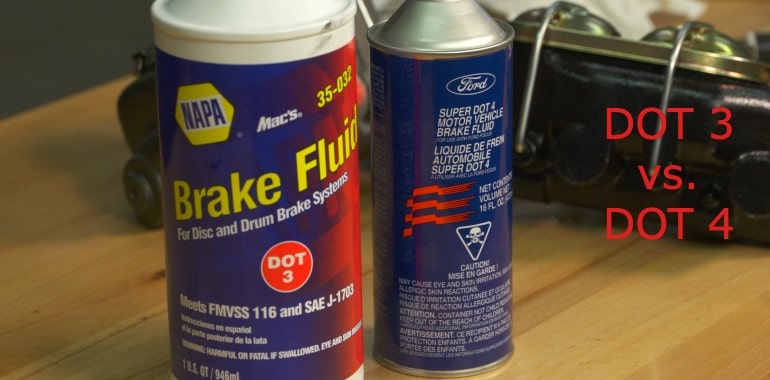by Joshua Thomas
When picking up brake fluid, many motorists will get either DOT 3 or DOT 4. Brake fluids are classified by the US Department of Transport, which explains the DOT initials.
While the Department of Transportation does not have any strict brake fluid formula manufacturers have to adhere to, they still have to meet some specific rating requirements.
The requirements relate to equilibrium reflux boiling points, pH values, kinematic viscosities, oxidation resistance, and a few other elements.

| Header | DOT 3 | DOT 4 |
|---|---|---|
| Dry Boiling Point | 205°C (401°F) | 230°C (446°F) |
| Wet Boiling Point | 140°C (284°F) | 155°C (311°F) |
| Composition | Glycol Ether | Glycol Ether/Borate Ester |
The most obvious difference between these two brake fluid types is the boiling point, and here they differ in both the dry and boiling points. Dry boiling point is the temperature at which new brake fluid straight from a container will boil.
DOT 3 has a lower dry boiling point (205°C/401°F) than DOT 4 (230°C/446°F), meaning it cannot handle high-temperature operations well as it will evaporate much faster.
The wet boiling point measures the temperature at which the brake fluid will boil when contaminated by water. The wet boiling point provides a real-world situation, given that it is almost impossible to use brake fluid without some moisture absorption.
For the wet boiling point, the measurements are taken when the fluid has around 3.7% water. The wet boiling points are much lower with both DOT 3 and DOT 4 than the dry ones. DOT 3 boils at 140°C/284°F when wet, while DOT 4 boils at 155°C/311°F.
The Department of Transport does not have a specific formula that brake fluid manufacturers must follow when making DOT 3 and DOT 4 brake fluids. But, the chemical composition of the two differs significantly.
DOT 3 often has around 80% glycol ether as the base. This base is a polyalkylene glycol and ether blend. This glycol ether blend is perfect for regular cars as their brake systems do not need to work in extreme temperatures.
The formula for DOT 4 has around 50 to 65% glycol ether base and between 20 and 30% borate ester. This combination is what gives it higher boiling points.
While both DOT 3 and DOT 4 are hygroscopic, they absorb water at different rates. But given the lower boiling point, DOT 3 absorbs water much faster than DOT 4. Faster water absorption speeds up the rate at which the fluid degrades, meaning it will require more frequent replacements to maintain optimal brake systems performance.
Therefore, vehicles that use DOT 3 may require more frequent brake fluid changes than those that use DOT 4. That said, how you use the car is still the primary determinant of brake fluid change frequency. For example, regular driving vehicles that use DOT 3 require less frequent brake fluid changes than the aggressively driven racing cars that use DOT 4.
When it comes to picking between DOT 3 and DOT 4, the ideal choice for you depends on the vehicle type you drive, how you drive, and the typical environment where you use the car.
DOT 3 is often the right choice for regular commute cars and trucks since there is less stopping, and braking is not very aggressive. However, for others like motorcycles, racing vehicles, and police cars, DOT 4 is ideal, given the more frequent and aggressive braking.
That said, the best way to determine the correct brake fluid for your vehicle when it is time for a replacement is by checking what the manual recommends |
 |
 |
 |

About Joshua Thomas
Joshua Thomas just simply loves cars and willing to work on them whenever there's chance... sometimes for free.
He started CarCareTotal back in 2017 from the advices of total strangers who witnessed his amazing skills in car repairs here and there.
His goal with this creation is to help car owners better learn how to maintain and repair their cars; as such, the site would cover alot of areas: troubleshooting, product recommendations, tips & tricks.
Joshua received Bachelor of Science in Mechanical Engineering at San Diego State University.
Just Car Care